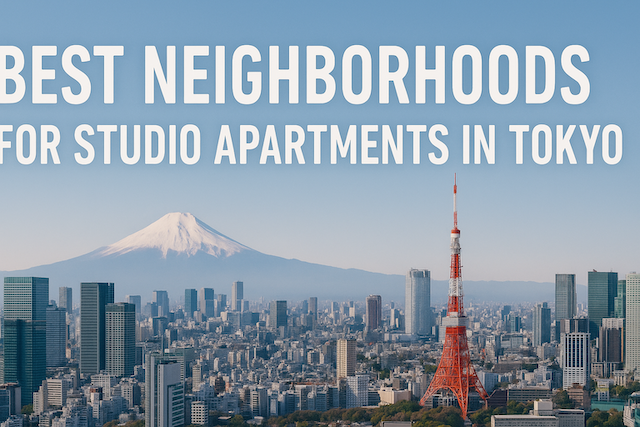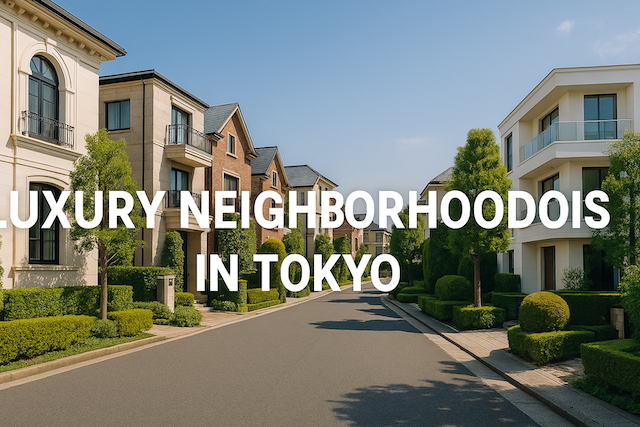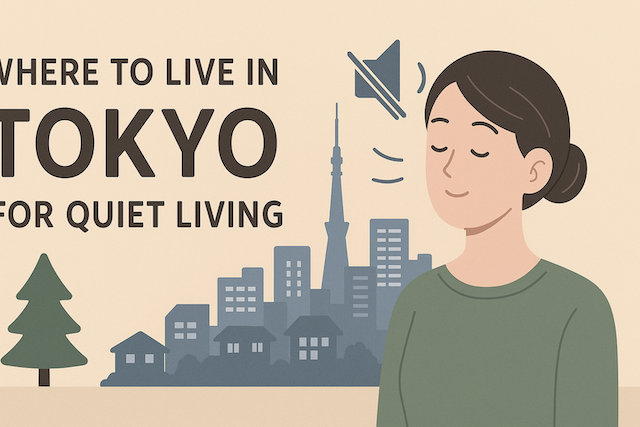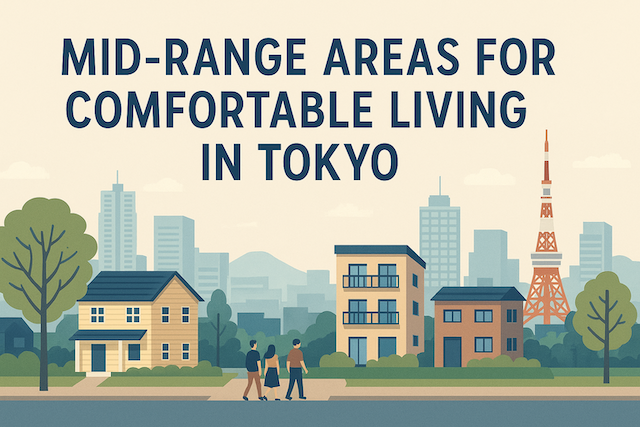Best Neighborhoods for Studio Apartments in Tokyo
Finding the perfect studio apartment in Tokyo can be both exciting and overwhelming. With so many neighborhoods offering different vibes, price ranges, and conveniences, it’s essential to know where to start your search. Whether you’re a student, a digital nomad, or a professional looking for a minimalist lifestyle, Tokyo has countless areas ideal for compact living. This guide explores the best neighborhoods for studio apartments in Tokyo, considering affordability, location, transportation, and lifestyle amenities.
Why Choose a Studio Apartment in Tokyo
Studio apartments — often called 1R (one room) or 1K (one room with a small kitchen) in Japan — are a popular choice for singles and young professionals. They provide a manageable space that’s easy to clean, efficient, and typically located near train stations.
Some key advantages include:
-
Affordability: Studios are usually cheaper than multi-room apartments.
-
Convenience: Many are located near public transport and local amenities.
-
Minimalist lifestyle: Encourages simplicity and efficient use of space.
-
Low maintenance: Ideal for busy city life or short-term stays.
However, the experience varies greatly depending on the neighborhood. Rent, accessibility, and atmosphere can make a huge difference in comfort and quality of life.
Shinjuku: Central and Convenient
Shinjuku is one of the most popular districts for studio apartment hunters, especially for those who want to be in the center of everything. The area combines nightlife, shopping, and direct access to nearly every part of Tokyo.
Why it’s great for studio living:
-
Multiple train lines: Shinjuku Station connects JR, Metro, and private lines, making commuting incredibly convenient.
-
Abundant apartment options: From budget-friendly units in Shin-Okubo to upscale modern studios in Nishi-Shinjuku.
-
Urban lifestyle: Ideal for those who love the city buzz and late-night dining.
Average rent: ¥90,000–¥130,000 per month (depending on proximity to station and apartment age).
Best sub-areas: Nishi-Shinjuku, Okubo, Yoyogi, and Takadanobaba (technically Shinjuku Ward but more residential).
Nakano: Affordable and Local
Just one stop west of Shinjuku, Nakano offers a more relaxed residential vibe with excellent prices for its central location. It’s famous for Nakano Broadway, anime culture, and local eateries.
Why Nakano works for studio apartments:
-
Lower rent than central wards but still easy access to major hubs.
-
Community feel with cozy streets and family-owned shops.
-
Quick JR access via Chuo Line straight to Shinjuku (5 minutes).
Average rent: ¥70,000–¥100,000 per month.
Ideal for: Students, freelancers, or anyone wanting a balance between convenience and affordability.
Ebisu: Stylish and Sophisticated
Ebisu is one of Tokyo’s trendiest areas, perfect for those who want a compact space without sacrificing lifestyle. It’s filled with chic cafés, high-end restaurants, and easy access to Shibuya and Meguro.
Why Ebisu is perfect for small apartments:
-
High-end studio options in modern buildings.
-
Great for professionals working in central Tokyo.
-
Vibrant dining scene and walkable streets.
Average rent: ¥120,000–¥160,000 per month.
Vibe: Elegant, urban, and international — perfect for expats or professionals in finance or creative industries.
Kichijoji: Green and Lively
Frequently ranked as one of Tokyo’s most desirable neighborhoods, Kichijoji combines nature, shopping, and a youthful atmosphere. Inokashira Park and Sunroad Shopping Street make it a pleasant area to live in.
Why Kichijoji suits studio living:
-
Balanced lifestyle — greenery, culture, and nightlife.
-
Great transportation — JR Chuo and Keio Inokashira lines.
-
Modern yet cozy studios — often with good amenities.
Average rent: ¥80,000–¥120,000 per month.
Who it’s for: Artists, young professionals, and anyone seeking a lively yet comfortable neighborhood.
Meguro: Calm and Well-Connected
Meguro offers a peaceful residential atmosphere within minutes of Shibuya and Ebisu. It’s ideal for those who want calm surroundings while staying close to the city’s action.
Why Meguro is great for studio apartments:
-
Quiet streets with greenery.
-
Excellent transit access (Meguro Station serves JR Yamanote, Tokyo Metro Namboku, and Tokyu Meguro lines).
-
Stylish low-rise buildings with modern studio units.
Average rent: ¥100,000–¥140,000 per month.
Perfect for: Singles or couples who prefer elegant and serene urban living.
Asakusa: Cultural and Budget-Friendly
Asakusa blends old Tokyo charm with affordable modern living. It’s an excellent area for those who love traditional vibes, temples, and access to the Sumida River.
Why Asakusa stands out:
-
Lower rent compared to central Tokyo.
-
Unique atmosphere with temples, festivals, and riverside views.
-
Convenient transport via Tokyo Metro Ginza Line and Toei Asakusa Line.
Average rent: ¥65,000–¥90,000 per month.
Ideal for: Artists, students, or expats who want a taste of “Old Tokyo” with modern conveniences.
Shimokitazawa: Bohemian and Youthful
Known for its vintage shops and indie cafés, Shimokitazawa is a magnet for creatives and young residents. It’s compact, trendy, and full of life — ideal for small apartments.
Why it’s great for studio seekers:
-
Trendy yet laid-back atmosphere.
-
Renovated studio buildings catering to young tenants.
-
Easy access to Shibuya and Shinjuku via Odakyu and Keio lines.
Average rent: ¥80,000–¥110,000 per month.
Vibe: Youthful, alternative, and ideal for people in arts, design, or tech.
Ikebukuro: Affordable and Accessible
Ikebukuro offers excellent value for money with plenty of entertainment, dining, and shopping options. Despite being one of Tokyo’s busiest hubs, there are many affordable studio options nearby.
Why Ikebukuro is ideal for studio living:
-
Excellent train connections (JR Yamanote, Seibu, Tobu, Metro lines).
-
Affordable studio choices around the outer edges of the district.
-
Plenty of convenience stores and 24-hour services.
Average rent: ¥75,000–¥110,000 per month.
Recommended sub-areas: Mejiro, Otsuka, and Minami-Ikebukuro for quieter living near the action.
Ueno: Cultural and Convenient
Ueno is a fantastic area for those who appreciate museums, parks, and an older Tokyo feel. It’s also well-connected to both central Tokyo and Narita Airport.
Why Ueno suits small apartment dwellers:
-
Reasonable rent for central Tokyo.
-
Close to nature with Ueno Park nearby.
-
Rich cultural scene — museums, art galleries, and historical sites.
Average rent: ¥70,000–¥100,000 per month.
Perfect for: Students, expats, or anyone who enjoys culture and convenience.
Koenji: Creative and Affordable
Koenji is a lively neighborhood popular with musicians, artists, and young professionals. It has a distinct retro charm with small live houses, thrift stores, and unique cafés.
Why Koenji works for studio apartments:
-
Affordable rents compared to nearby areas like Nakano and Shinjuku.
-
Cultural hotspot with festivals and nightlife.
-
Strong community vibe.
Average rent: ¥70,000–¥95,000 per month.
Best for: Creative professionals or anyone seeking a local Tokyo lifestyle.
Oimachi: Balanced and Residential
Oimachi in Shinagawa Ward offers a practical blend of affordability, quiet living, and excellent transport. It’s a great choice for commuters who want to live outside the dense central wards.
Why Oimachi is worth considering:
-
Lower rent but strong connectivity (JR Keihin-Tohoku, Rinkai, and Tokyu Oimachi lines).
-
Lots of supermarkets and daily conveniences.
-
Easy access to Shinagawa and Haneda Airport.
Average rent: ¥70,000–¥100,000 per month.
Vibe: Relaxed, local, and ideal for working professionals.
Daikanyama: Chic and Compact
Daikanyama is a stylish enclave near Shibuya, known for its upscale but cozy feel. Though prices are higher, it’s ideal for those seeking premium studio apartments in a serene yet fashionable environment.
Why Daikanyama is popular for studio living:
-
Boutique-style buildings and modern amenities.
-
Walking distance to Shibuya.
-
Quiet yet full of upscale cafés and stores.
Average rent: ¥130,000–¥180,000 per month.
Best for: Professionals who value luxury and design.
Tips for Finding a Studio Apartment in Tokyo
-
Use local real estate platforms like Suumo, Homes, and Chintai — they offer filters for 1R and 1K listings.
-
Check train line access — commuting convenience often outweighs size.
-
Be flexible with age and layout — older apartments can be much cheaper.
-
Watch for hidden costs like key money (reikin), deposit (shikikin), and maintenance fees.
-
Consider surrounding wards — often, being one station away can save tens of thousands of yen monthly.
Final Thoughts
Tokyo offers a neighborhood for every lifestyle, from the artsy streets of Shimokitazawa to the upscale calm of Daikanyama. For those looking for a studio apartment, the key is to balance rent, location, and personal lifestyle preferences.
If you want excitement and convenience, Shinjuku or Ebisu might suit you best. For affordability and community, Nakano, Koenji, or Oimachi are excellent. And for a greener, more relaxed experience, Kichijoji or Meguro are top picks.
No matter which neighborhood you choose, living in a Tokyo studio apartment offers an efficient and uniquely urban way to experience one of the world’s most dynamic cities.
What is a “studio” in Tokyo, and how do 1R and 1K differ?
In Japan, a studio is typically labeled 1R (one room with kitchenette in the main space) or 1K (one room plus a separate small kitchen behind a door). 1K offers better odor/noise separation and slightly more storage, while 1R is usually cheaper and more compact.
How much does a studio apartment cost by neighborhood?
Budget-friendly areas like Asakusa, Koenji, and Nakano often range around ¥65,000–¥100,000. Mid-range hubs like Ikebukuro, Ueno, Kichijoji, and Shimokitazawa run roughly ¥75,000–¥120,000. Premium locations such as Meguro, Ebisu, and Daikanyama typically start near ¥110,000 and can exceed ¥160,000 depending on building age and proximity to stations.
What upfront costs should I expect beyond monthly rent?
Initial costs often include deposit (shikikin), key money (reikin), agency fee, lock exchange, cleaning fee, and the first month’s rent and maintenance fee. As a rule of thumb, plan for 3–5 months of rent equivalent upfront. Zero-key-money or zero-deposit listings exist, but total move-in costs rarely drop to just one month.
Is key money still common in Tokyo?
Yes, but it’s less universal than before. Many modern or corporate-managed buildings waive reikin to attract tenants, especially outside peak season or slightly farther from major stations. If key money is required, it’s commonly one month of rent and is non-refundable.
Do I need a guarantor, and what if I don’t have one?
Most landlords require a guarantor. If you don’t have a qualifying Japanese guarantor, you’ll typically use a guarantor company. Expect an initial guarantor fee (often 30–100% of monthly rent, minimums apply) and a small annual renewal fee.
Are furnished studios common?
Standard long-term rentals are usually unfurnished (no bed, sometimes no lighting or curtains). Furnished options exist through serviced apartments, share houses, or select operators near central hubs. Expect higher monthly rent for furnished units and shorter minimum lease terms compared to conventional unfurnished studios.
What lease terms are typical for studios?
Most long-term leases are two years with renewal fees every two years (often one month’s rent). Early termination usually requires one month’s notice. Shorter terms are possible via serviced apartments or monthly rentals, though the effective monthly cost is higher.
How do I keep total housing costs down?
Prioritize neighborhoods one or two stations from major hubs, choose older but well-maintained buildings, consider 1R over 1K, and look for properties with zero reikin or reduced deposits. Signing off-peak (late winter or summer) and widening your acceptable walk distance (10–15 minutes) can also cut costs.
Which neighborhoods balance affordability and access?
Nakano, Koenji, and Oimachi offer strong value with convenient lines and lively local amenities. Ikebukuro and Ueno add big-station connectivity at reasonable prices, while Kichijoji and Shimokitazawa bring lifestyle perks (parks, indie culture) at still-manageable rents compared to premium central wards.
What should I check during viewings?
Measure the doorways and layout; confirm washer placement, fridge space, and storage. Test water pressure, ventilation, and noise levels (hallway, street, trains). Inspect for mold, sunlight, and mobile signal. Ask about internet options, garbage rules, bicycle parking, and total monthly fees (including building maintenance).
How important is proximity to the station?
It’s the biggest rent driver. Being within five minutes on foot can add notable cost, but it improves commuting, safety late at night, and resale-like appeal when you move out. If budget is tight, accept a 10–15 minute walk to unlock larger or newer units for the same price.
Are utilities and internet included?
In conventional leases, utilities and internet are rarely included. You’ll set up electricity, gas, water, and broadband separately. Some modern buildings offer building-wide fiber for a small monthly fee. Monthly apartments and share houses more often bundle utilities and Wi-Fi into the rent.
How does building age affect rent and comfort?
Older buildings (pre-2000s) are typically cheaper and may have smaller bathrooms or less insulation. Newer properties improve soundproofing, security, layout efficiency, and earthquake standards. If you choose older, verify renovation history (kitchen, bath, flooring) to balance savings with comfort.
Is it difficult for foreigners to rent studios in Tokyo?
Many agencies and landlords welcome foreign tenants, especially in hubs like Shinjuku, Ebisu, and Ikebukuro. Using a guarantor company, preparing documents (ID, residence card, income proof), and working with English-friendly agents streamline approvals. Flexibility on move-in timing and building rules helps.
What documents do I need to apply?
Typically: photo ID, residence card (if applicable), proof of income or employment, bank details, emergency contact, and application form. Students may submit enrollment confirmation and financial backing. Expect a background and credit check via the guarantor company.
How do studio sizes compare, and what’s livable for daily life?
Studios commonly range 16–25 m². Under 18 m² requires careful furniture planning (loft beds, foldable tables). Around 20–22 m² suits most single tenants with a compact bed, desk, and storage. Over 24 m² feels comfortable if you cook often or work from home.
Are pets allowed in studio apartments?
Pet-friendly studios exist but are limited and may require higher deposits or monthly “pet rent.” Expect stricter cleaning clauses and noise rules. Neighborhoods with nearby parks (Kichijoji, Meguro) can be attractive for pet owners, but verify building policies before applying.
How does neighborhood “vibe” impact studio living?
Shinjuku and Ikebukuro offer big-city convenience and late-night services; Ebisu and Daikanyama deliver upscale dining and calm streets; Kichijoji and Shimokitazawa add greenery and culture; Asakusa and Koenji bring classic or indie charm. Pick a vibe that matches your schedule and noise tolerance.
What are common mistakes first-time renters make?
Focusing only on rent without counting total move-in costs, underestimating travel time, ignoring maintenance fees, overlooking storage, and skipping noise/sunlight checks. Another pitfall: waiting too long to apply. Good studios near major lines move quickly—submit promptly once you’ve confirmed fit.
When is the best time to secure a good deal?
Competition spikes between January and March. Better bargains appear in shoulder periods (late spring, mid-summer, early autumn). Keep alerts on major listing platforms, expand search radius by a station or two, and consider slightly older buildings to maximize value without sacrificing access.
https://tokyorelocationguide.com/neighborhoods/





![Where to Live in Tokyo for Couples [2025-2026 Guide]](https://tokyorelocationguide.com/wp-content/uploads/2025/10/ChatGPT-Image-Oct-17-2025-04_22_42-PM.png)

